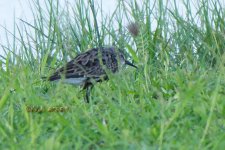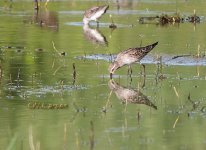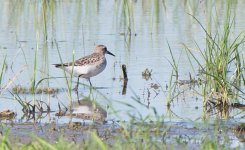-
Welcome to BirdForum, the internet's largest birding community with thousands of members from all over the world. The forums are dedicated to wild birds, birding, binoculars and equipment and all that goes with it.
Please register for an account to take part in the discussions in the forum, post your pictures in the gallery and more.
You are using an out of date browser. It may not display this or other websites correctly.
You should upgrade or use an alternative browser.
You should upgrade or use an alternative browser.
Another peep Barbados (1 Viewer)
- Thread starter njlarsen
- Start date
More options
Who Replied?Indobirder
Well-known member
Looks like a Dunlin
Looks like a Dunlin
I agree. So that dark patch in the belly area probably isn't an artefact
rollingthunder
Well-known member

I expect you to identify.....Mr Bond
Laurie:t:
Laurie:t:
Indobirder
Well-known member
What does the reviewer think it is?
I guess maybe Western, or White-rumped? Of the two I think it looks better for Western.
I'd like to retract my earlier ID.
I guess maybe Western, or White-rumped? Of the two I think it looks better for Western.
I'd like to retract my earlier ID.
Andy Adcock
Worst person on Birdforum

What does the reviewer think it is?
I guess maybe Western, or White-rumped? Of the two I think it looks better for Western.
I'd like to retract my earlier ID.
Ditto.
rollingthunder
Well-known member

Before reading further comments i looked at the depth, length and shape of bill and thought Western.....and i have never seen one:eek!:
Laurie:t:
Laurie:t:
Mark Lew1s
My real name is Mark Lewis
The long PP fits white-rumped better than western sandpiper. It looks long but don't find the bill excessively long for WRS.
tom baxter
Well-known member
The long PP fits white-rumped better than western sandpiper. It looks long but don't find the bill excessively long for WRS.
I remember looking at this when it was first posted and refrained from contributing my impression mainly because I’m not sure what it is. I doubted Dunlin was correct from the get. As for long pp, I simply don’t get the same impression. To my eyes the pp appears short and eliminates white-rumped as a candidate. My best guess is western but personally I’d leave it as calidris sp
ovenbird43
Well-known member

I agree that Western seems the best fit. Overall impression is of a short-winged peep sp., with that bill more suggestive of Western but not conclusively so.
SteveClifton
Well-known member
The long PP fits white-rumped better than western sandpiper. It looks long but don't find the bill excessively long for WRS.
Completely with you on this Mark.
I must admit to looking in on this thread a couple of times, but never had a proper look until now.
I can see the superficial resemblance to Dunlin, and also to Western, but those heavy dark shaft streaks on the 2nd generation scapulars should readily rule out Western Sandpiper. It's one of the key features we look at in Europe to separate Little Stints from Western and Semi-Ps-especially so with the rear-most feathers of L Stint. Both Western & Semi-P have fine pencil lines along the feather shafts of all of their new 'adult winter' type scapulars.
Once you consider the above, and have a good look at the bird with moulting 1cy White-rumped Sandpiper in mind, everything points to that species:
The long pp (sorry if you can't see it, but it's clearly there), pale-tipped greater coverts (and medians too?), heavy dark-centred juvenile scaps alongside the new grey ones (with heavy, black triangle-shaped shaft streaks), pattern on the lesser coverts (dark centres with contrasting pale fringes), face pattern, bill length and shape etc.
Compare the bird with this one if you need further convincing:
https://www.cbwps.org.uk/cbwpsword/tag/white-rumped-sandpiper-in-cornwall/
The gingery tones are there too (e.g on the fringes of some of the tertials, also on the edges of the greater coverts), though I think heavy (in camera?) processing has skewed the real colours somewhat. I could be wrong but isn't there also a hint of colour at the base of the lower mandible? ...Maybe a step too far...?
Last edited:

Thank you all for the discussion. I have my doubts about this being White-rumped: I will here attach a couple of other images of white-rumped taken here during october. Differences as I see these are in supercilium and wing length in addition to general tone
thanks
Niels
thanks
Niels
Attachments
Users who are viewing this thread
Total: 2 (members: 0, guests: 2)






